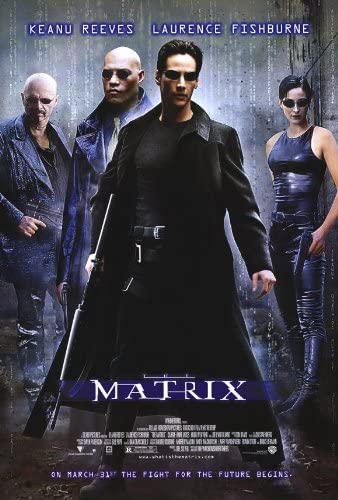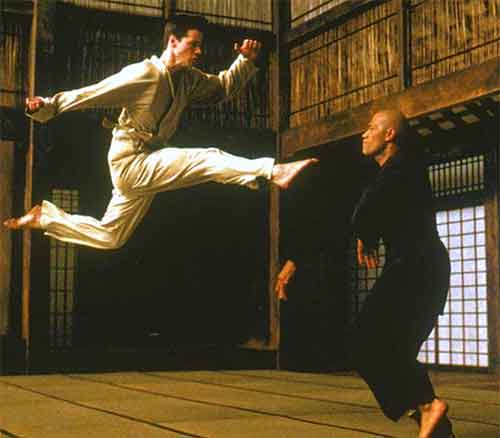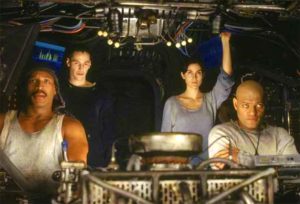 Yes, children: 1999’s THE MATRIX was once the coolest thing around. A flashy Hollywood blockbuster that mixed science fiction, action and philosophy, it contained imagery—a woman leaping up and freezing in midair, bullets making air ripples—that was pretty unprecedented. The story is nothing special, being a grab-bag of clichés established by writers like Philip K. Dick and William Gibson, filtered through a nineties hipster sensibility. That failed to halt the film’s massive success, which handily overshadowed 1999’s other big-ticket science fiction releases eXistenZ and THE PHANTOM MENACE (something those films’ makers David Cronenberg and George Lucas were none too happy about, with both making sure to dis THE MATRIX roundly).
Yes, children: 1999’s THE MATRIX was once the coolest thing around. A flashy Hollywood blockbuster that mixed science fiction, action and philosophy, it contained imagery—a woman leaping up and freezing in midair, bullets making air ripples—that was pretty unprecedented. The story is nothing special, being a grab-bag of clichés established by writers like Philip K. Dick and William Gibson, filtered through a nineties hipster sensibility. That failed to halt the film’s massive success, which handily overshadowed 1999’s other big-ticket science fiction releases eXistenZ and THE PHANTOM MENACE (something those films’ makers David Cronenberg and George Lucas were none too happy about, with both making sure to dis THE MATRIX roundly).
A flashy Hollywood blockbuster that mixed science fiction, action and philosophy…
It was written and directed by the Wachowski siblings Lilly and Lana (back when they were known as Andy and Larry). Their second feature (following 1996’s less successful BOUND), THE MATRIX reportedly sprang from a graphic novel proposal, something that’s evident in the heavily storyboarded comic book-like imagery. It was produced by the veteran action-meister Joel Silver (of COMMANDO, LETHAL WEAPON, DIE HARD and countless other blockbusters), and stands as perhaps the only one of his more “daring” projects (which include STREETS OF FIRE and THE HUDSUCKER PROXY) that produced any real results box office-wise. It may well be Silver’s influence that bequeathed THE MATRIX’S gun and martial arts-heavy orientation, which seems a bit gratuitous if you ask me.
The film’s impact is evident in the many lines from its script that have entered the pop culture lexicon—“take the red pill,” “I know Kung Fu,” etc.—and the fact that so much of it has been copied so shamelessly. It’s a fact that THE MATRIX’S particulars have been replicated too many times to fully measure (including by the Wachowskis themselves in 2015’s JUPITER ASCENDING), but so have many of its production details. It was filmed largely in Sidney, AU, which became a movie hotspot in the following years (the second and third STAR WARS prequels partook quite generously of the Australian production facilities established by THE MATRIX), and its martial arts coordinator, the legendary Hong Kong based Yuen Woo Ping, became a Hollywood player after working on THE MATRIX (with subsequent credits that include KILL BILL and FEARLESS).
The story involves Neo, a dissatisfied computer nerd. He keeps hearing about something called the Matrix, and getting harassed by a band of officious creeps led by the evil Agent Smith. Neo meets some black trench coat wearing rivals to Smith and his minions, a group led by a middle-aged African American named Morpheus and a hot chick named Trinity. They reveal to Neo the Truth: that what we take for “reality” is actually the aforementioned Matrix, a computerized hallucination created by machines who seek to use us for energy. Neo, it seems, is the Chosen One fated to rescue humanity from the machines’ grip, but he’s opposed by Agent Smith and his minions, who plant a mole amid the rebels and kidnap Morpheus. How to save the day? With lots of guns, of course!
Once again: this all seemed quite innovative back in ‘99, but that innovation has long since worn off. The film’s trendy late-nineties stylings date it a great deal, as do the primitive CGI and kill-happy arc (given all the neat powers Neo and his fellows have, is embarking on a massive shooting rampage to save Morpheus really a sound course of action?). We’re also left, in the absence of that initial innovation, with acting that by and large isn’t very impressive.
The film’s trendy late-nineties stylings date it a great deal, as do the primitive CGI and kill-happy arc…
 Keanu Reeves has an oddly distracted and not-quite-there air as Neo, while Lawrence Fishburne is too solemn as Morpheus and Hugo Weaving too one-dimensional as Agent Smith (some Alan Rickman-like shading would have benefitted the character greatly). There is, however, one indisputably great performance, delivered by the late Gloria Foster as the cookie baking Oracle. The character could have been presented with a bit more clarity (she appears to know the future yet somehow misidentifies Neo’s role in it), but Foster clearly understand the movie’s loopy tone better than any of the other cast members, and delivers a beautifully rounded, unshowy turn.
Keanu Reeves has an oddly distracted and not-quite-there air as Neo, while Lawrence Fishburne is too solemn as Morpheus and Hugo Weaving too one-dimensional as Agent Smith (some Alan Rickman-like shading would have benefitted the character greatly). There is, however, one indisputably great performance, delivered by the late Gloria Foster as the cookie baking Oracle. The character could have been presented with a bit more clarity (she appears to know the future yet somehow misidentifies Neo’s role in it), but Foster clearly understand the movie’s loopy tone better than any of the other cast members, and delivers a beautifully rounded, unshowy turn.
Other still-interesting elements include the philosophical chatter that punctuates the action, a combination that would never fly in modern-day Hollywood but proves surprisingly harmonious, and the fluidness of its virtual reality settings. No subsequent Hollywood movie (no, not even INCEPTION) has come close to matching the audacity of THE MATRIX’S ever-shifting universe, in which characters move in and out of differing levels of reality that are at times encompassed by a pure white screen (a non-setting that was also utilized quite effectively in Vincenzo Natali’s 2003 comedy NOTHING).
Speaking of subsequent movies, here I guess would be an opportune spot to discuss THE MATRIX’S inevitable sequels THE MATRIX RELOADED, THE MATRIX REVOLUTIONS (both 2003) and an upcoming fourth installment—or better yet not, because (the not-yet-released fourth entry excepted) those films did nothing to further their progenitor’s legacy outside of making one wonder whether that legacy was ever truly worth considering.
Vital Statistics
THE MATRIX
Warner Bros.
Directors: Lana Wachowski, Lily Wachowski
Producer: Joel Silver
Screenplay: Lily Wachowski, Lana Wachowski
Cinematography: Bill Pope
Editing: Zach Staenberg
Cast: Keanu Reeves, Laurence Fishburne, Carrie-Anne Moss, Hugo Weaving, Gloria Foster, Joe Pantoliano, Marcus Chong, Julian Arahanga, Matt Doran, Belinda McClory, Anthony Ray Parker, Paul Goddard, Robert Taylor, David Aston, Marc Gray

